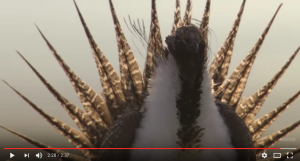Inspiration for Better Days
4th of Apr 2017
By John McCarthy
April 4th, 2017
Spring brings back the flamboyant courtship dance of the greater sage-grouse in scattered spots known as “leks”from Montana to California.
Spring 2017 also brings uncertainty on how politics and industrialization may affect efforts to coordinate conservation for the vulnerable and venerable bird.
 Legislation introduced in February by Sen. Jim Risch, (R-Idaho) and Rep. Rob Bishop (R-Utah) could scuttle a cooperative, regional conservation plan finalized in 2015. The proposed bills give priority to separate state plans, which would weaken and fracture nearly 20 years of west-wide sage-grouse protection efforts.
Legislation introduced in February by Sen. Jim Risch, (R-Idaho) and Rep. Rob Bishop (R-Utah) could scuttle a cooperative, regional conservation plan finalized in 2015. The proposed bills give priority to separate state plans, which would weaken and fracture nearly 20 years of west-wide sage-grouse protection efforts.
Fragmentation of sage-grouse habitat is the primary threat to species survival, with more than half of their historic range already lost to development and degradation. And increased pressure on western states from oil and gas, agriculture, and development lobbies further threatens sage-grouse recovery.
The new Secretary of Interior, Ryan Zinke of Montana, has yet to take any action on sage-grouse; but during his time in Congress, he opposed the multi-state land management plans of federal agencies to protect the iconic bird. Now that Zinke is overseeing the Bureau of Land Management– the primary land management agency for sage-grouse habitat – his directives will be critical.
Advocates for the West represents four conservation clients seeking to strengthen the 2015 plans and give teeth to its restrictions on development across 70 million acres of BLM and Forest Service land. Other opposing cases are pending from the oil and gas industry, mining companies, and the states of Utah and Nevada–all designed to weaken restrictions on energy development, agriculture and mining.
The Trump administration and Zinke’s response to industry court cases could lead to closed settlements favorable to developers and bad for birds. Regardless of legislation, implementation of the 2015 plans could also be undercut and delayed by the new administration through budget cuts, demands for new studies and lack of agency support.
Representatives of governors in Wyoming, Republican Matt Mead, and Colorado Democrat John Hickenlooper, have said the 2015 cooperative plan are flexible enough to meet their state interests. But the legislation introduced by Risch and Bishop removes incentives for state and federal cooperation.
The Risch/Bishop bill also postpones any consideration of Endangered Species Act listing for sage-grouse for an additional seven years beyond the 2020 deadline in the federal plan. By 2027, it may be too late for sage-grouse to thrive and many years of planned conservation actions could be bypassed and squandered.
Agency inaction, state agitation, political interference, industry pressure and ongoing habitat fragmentation present a grim picture for sage-grouse. As an indicator species, reflecting the health of the entire sagebrush ecosystem, the future of sage-grouse has far reaching implications.
To be inspired for better days, the sage-grouse dance is one of the wonders of nature —happening soon at a spring-scented sagebrush steppe location near you —if you are lucky.
John McCarthy spent decades on staff at conservation organizations, before turning it over to able younger people and becoming a jazz disc jockey at Radio Boise.

